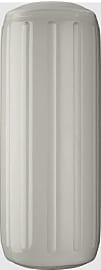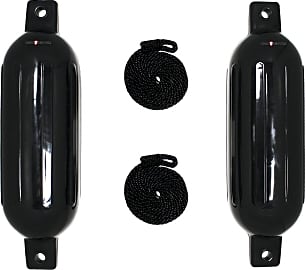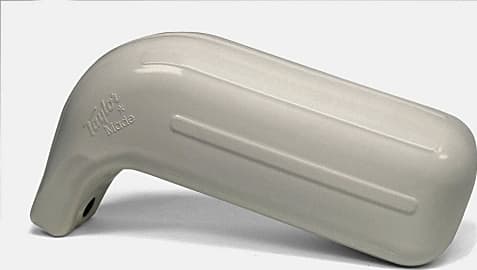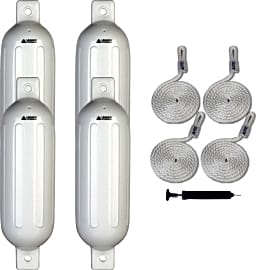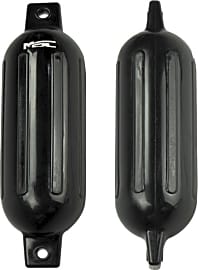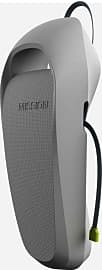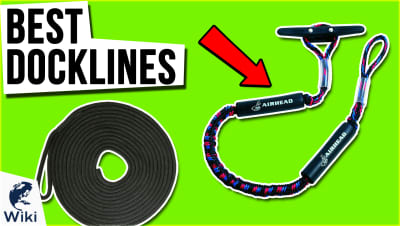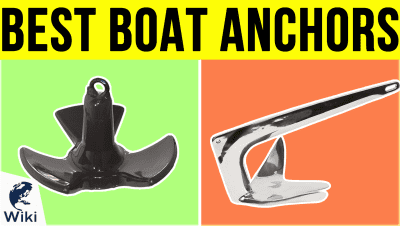The 10 Best Boat Fenders

This wiki has been updated 36 times since it was first published in January of 2016. You probably paid a reasonable amount of money for your boat, so it makes sense to protect it with a set of high-quality fenders. We've found center hole and two-eye models, as well as some innovative options, that will help to prevent dents and dings to your hull and rub-rail when docked, rafting up, or on a trailer, so your paint job stays in tiptop shape season after season. When users buy our independently chosen editorial choices, we may earn commissions to help fund the Wiki.
Editor's Notes
December 10, 2019:
Fenders are your boat's best defense against scratches and abrasion from docks or other vessels when rafting up, so it is important to buy high-quality units that can stand up to the abuse they are protecting your vessel from.
While there have been many variations on the traditional oblong fender shape and attempted improvements, few, if any, have really proven more effective, which is why that style makes up the majority of our list. Models like the Norestar Ribbed Four-Pack, Polyform G Series, Extreme Max BoatTector, Leader Accessories Ribbed Twin Eyes Four-Pack, and MSC Vinyl Ribbed have a twin-eye design, which means they have an eyelet on either end that you attach a rope to. One of the benefits of this form is that they can be used with a shorter rope than hole-through-the-middle options. Considering that dock line is rather expensive, this can help you save a few bucks to fill up that gas tank.
However, we also realize that some people may prefer the versatility and ease of use of hole-through-the-middle options like the Polyform HTM Series and Taylor Made Big B. Not only do these have two less points of potential failure, they require less knot tying since they utilize a single rope.
While we feel the classics are still the best and generally the most durable, purpose-made options can still be a good idea for some situations. For example, if you have a vessel that sits low in the water or has short gunwhales and you often tie up to a high dock, the Taylor Made Low Freeboard can be very effective at protecting it from damage and scuff marks. The Kwik Tek Hull Hugr 1CB is another example that is ideal for specific situations. Its long, flat shape makes it perfect for use in conditions where oblong models may easily roll out of position.
What Are Boat Fenders?
Most boats make use of mobile fenders that are hung from the side of the boat just before docking.
Marine fenders are essentially bumpers that can prevent damage to a boat, dock, pier, or wharf. Navigating a vessel in water is very different that driving a car on land. There is no such thing as hitting brakes. The only way to quickly slow or stop a boat is by putting it in reverse and revving the engine thereby creating an opposing force from the momentum of the vessel. This means that when docking a boat, it is not uncommon for the vessel to bump against the dock or wharf. The same is true when rafting up to another boat. To minimize or completely eliminate the damage this causes, people invented fenders.
Fenders prevent damage to the body of a boat and the berthing structure by absorbing the kinetic energy of said vessel as it bumps up to the wharf or jetty for docking purposes. They are used on practically every type of seagoing vessel, from the smallest recreational boats to the largest of cruise ships and tankers.
Originally, fenders were made from thick woven rope in a variety of different patterns. Over time, fender technology has evolved, and they are now generally made from foam, rubber, or plastic, though traditional rope varieties can still be seen on some historic vessels. These new elastomer-based fenders have high energy absorption qualities with very low reaction force, making them ideal for the task at hand.
Most boats make use of mobile fenders that are hung from the side of the boat just before docking. These are usually lightweight pneumatic units. When at sea, the fenders are stored somewhere inside of the vessel, such as a storage bin, under a seat, in a dedicated fender rack, or tied alongside the inner railing. Piers and wharfs generally have permanent fender installations, usually made from solid rubber. In many instances, old car and truck tires are substituted as purpose-made boat fenders.
Common Types Of Boat Fenders
Boat fenders come in many different shapes and sizes. First, we must break them down into two major categories: permanent and mobile. Permanent fenders are affixed to docks and wharfs. If you have ever walked along a quay wall and seen black rubber bumpers running along its length, then you have seen some of these permanent fenders. The three most common permanent fenders are arch, W, and cylindrical. Each of these styles has their pros and cons. For example, cylindrical fenders are an economical option that offer ease of installation, whereas arch fenders have a better energy-to-reaction ratio, but are more costly and labor intensive to install. W fenders are best suited to quay walls that berth large tankers and cruise ships, as they have the highest rate of resistance, therefore offering the best protection against kinetic energy.
Since they only have a hole on one side in which to tie a rope, they can only hang vertically.
Unless you are looking to equip a private dock with permanent fenders, you are probably more interested in learning about the different varieties of mobile fenders. As with permanent units, these also come in a variety of shapes and sizes, each best suited to certain tasks. The most common of these are probably cylindrical fenders. Unlike permanent cylindrical fenders, the mobile varieties are pneumatic, making them very lightweight and easy to move. Cylindrical models can be further broken down into double-hole, single-hole, and center-hole units. Double-hole models have a hole on either end, allowing boaters to hang them vertically or horizontally depending on their needs. Center-hole models, also often referred to as hole-through-middle or HTM fenders, are also capable of vertical and horizontal positioning. Single-hole models are less versatile. Since they only have a hole on one side in which to tie a rope, they can only hang vertically.
Round fenders are another common type of boat fender. While some recreational boaters use them because they are great for raft-ups, storing them is a little more difficult due to their shape. This means they are often relegated to commercial anglers who use them as mooring and fishing line buoys, though they are actually a smart choice for large, recreational power boats that have deep-V concave hulls.
Some less common, but just as useful fender types include freeboard and transom. Freeboard fenders sit high on the hull and hang inward over the gunwale. They are ideal for smaller boats that sit low in the water since they protect the gunwale from damage caused by rubbing against the dock. Transom-mounted fenders have a deep V-groove that allows them to sit tightly on the transom. They are used to protect the boat when docking stern-to. This is by no means an exhaustive list though, as new types of fenders are developed on a regular basis.
Choosing The Right Size Fender For Your Boat
Fender size is dictated by the berthing energy of the vessel. The greater the berthing force, the larger a fender is needed. Berthing force is directly related to the weight and displacement of a boat. Much like when anchoring, one must also take common mooring conditions into account when choosing a fender, as well.
If berthing in rough, choppy water, a boat will need a higher level of protection that when berthing in a calm marina.
A good rule of thumb for cylindrical fenders is to have one inch of diameter per five feet of boat length. For round fenders, owners should look to have two inches of diameter per five feet of boat length. This is not a hard and fast rule though; it's more a general recommendation. If berthing in rough, choppy water, a boat will need a higher level of protection that when berthing in a calm marina. Also, heavier vessels, like sailboats, will need more fender diameter per five feet of boat length because they have a much higher berthing energy due to their greater weight.
It is also important to purchase the correct number of fenders in order to properly protect your boat. Ideally, you should have one fender per 10 feet of waterline, with a minimum of three overall. So, for example, a 20-foot boat should have three fenders deployed when docking, of at least four inches in diameter, since the minimum number trumps the waterline rule of thumb. A 40-foot boat should have four fenders deployed when docking, of at least eight inches in diameter.


